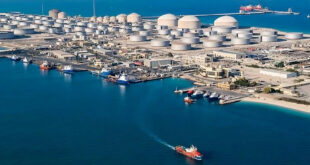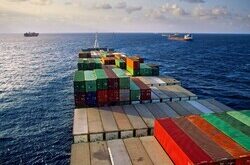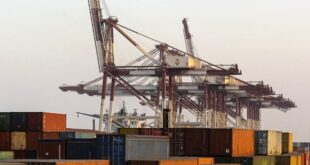A new report shows that Iran’s exports of steel skyrocketed by nearly 68 percent in the single month ending February 19, while 11-month records show that the outbound trade of the commodity rose by 28 percent in comparison with the corresponding period in last year.
A new report said on Thursday that steel exports from the country topped 6,513,123 million metric tons in a time span between March 21, 2019 and February 19, 2020, which indicates a surge of 28 percent compared to the similar period spanning 2018-2019.
Exports surged by nearly 68 percent in the single month ending February 19 with total shipments standing at 628,993 tons, said the report.
Khuzestan Steel, one of the largest mills in Iran, however, recorded a decline of 19 percent in exports in February, it said, adding that the holding’s 11-month exports also declined by 16 percent.
Iran is among the top 10 steel producers in the world with estimates suggesting the country could reach a target of 10 million tons of exports for the current year ending March 19.
That comes as the Iranian government seeks to increase total annual steel output to 55 million tons in the years to come with share of exports estimated to reach 40-45 percent of the total output.
The booming steel exports and production in Iran has come despite increasing American pressure on the industry as Washington has imposed specific sanctions targeting the country’s metals trade.
The bans, enacted in May 2019, have largely failed to stem the industry’s growth mainly because Iranian companies use third countries to process exports to the customers.
The Iranian government also refrains from releasing information about the weight of output in each specific steel mill in the country, with authorities insisting the data should be kept confidential to allow more exports at the time of sanctions.
Last month, a new international report showed that Iran’s steel output increased by 46.7% in the past 12 months, indicating a stunning jump 20 times bigger than the world average growth of 2.1% in the same period.
World Steel Association reported that Iran’s steel production grew by 46.7% which was 20 times more than the world average of 2.1%.
The WSA said that Iran has produced 2,895,000 tons of crude steel in January 2020 that shows a 46.7% growth compared to its previous year’s production in the same month which was 1,971,000 tons.
All the 64 steel-producing counties in the world have produced 154,436,000 tons of crude steel, which shows a 2.1 growth compared to January 2019 when the output was 151,228,000 tons.
China, India, Japan, the US, and Russia are respectively the biggest steel producers in the world.
Earlier in February, export statistics of large steel mills in Iran showed that in a year-on-year comparisons, Iran has registered a 25% rise in terms of exporting steel products in the first 10 months of the current local calendar year (from March 21, 2019 to Jan. 22, 2020).
The same report recounted that the country’s exports of different steel products in the 10-month span between March 21, 2019 to January 22, 2020, has hiked by 25% in comparison with the corresponding period in a year ago.
In the same period, 5,884,130 tons of steel products were exported from the country, showing a 25 percent growth as compared to the same period of last year.
The statistical tables of Iranian Steel Producers Association (ISPA) indicate that 5,069,000 tons of steel ingot was exported from the country in the nine months of the current Iranian calendar year (from March 21 to Dec. 22), recording a 38 percent growth as compared to the last year’s corresponding period.
The ISPA put the steel ingot exported from the country in the nine months of the last Iranian calendar year (from March 21 to Dec. 22, 2018) at 3,675,000 tons.
Another statistic showed that total 2,728,000 tons of steel products were exported from the country in the first nine months of the current year, showing a 27 percent hike as compared to the same period of last year.
The Iranian Ministry of Industry, Mine and Trade announced in December that the country’s steel sector has been making progress under US sanctions, adding that currently the country has an annual capacity of 35 million tons of steel production.
Deputy Minister of Industry, Mine and Trade Jafar Serqini said that Iran has currently 35 million tonnes of steel production capacity.
Steel exports will exceed 11 million tonnes this year, up 30 percent from 8.5 million tons last year, local sources quoted him as saying. This shows that Iran’s steel industry is rapidly moving forward.
According to Serqini, several steel units with an overall capacity of 10 million tons are currently being built with above 50 percent of physical progress, while another 10 million tons of capacity has been defined to be established.
All these efforts are aimed at reaching the target of 55 million tons of steel in the 20-year vision plan, he said.
For the past three to four years, steel production growth in Iran has always been higher than the global average, according to Serqini.
Iran’s industrial metals, specifically steel, are the latest target in the Trump administration’s maximum pressure campaign, but officials say the sector is unfazed and keeps growing.
Earlier in December, the US government launched the latest salvo in the campaign as it warned against exports of steel-making materials to Iran.
The US Department of State cautioned that those involved in transfers or exports to Iran of graphite electrodes and needle coke, which are essential materials for Iran’s steel industry, were at risk of sanctions regardless of their nationality or location.
Iran’s Minister of Industry, Mine and Trade Reza Rahmani put the damper on Washington’s haughty grandstanding, saying Iranian producers had obtained the technology to make graphite electrodes.
In the steel field, we identified the production of graphite electrodes as a chokehold and produced it domestically, Rahmani said.
In the same period, Iran’s ministry of industry issued a report recounting that the country has posted 7% year-on-year increase in production of various steel products, including bars, rods, profiles, sheets and plates, while the country’s output of crude steel, including blooms, billets, and slabs, had grown by five percent.
It shows that production of crude steel, including blooms, billets, and slabs, had increased by five percent in the eight-month period ending on November 21 to reach a total of 17.424 million tons.
Iran has stated that the sanctions have failed to affect plans for increased output as the country seeks to improve its position as a major steel producer in the world.
Output of various steel products was down year-on-year over the summer months and before the government imposed a harsh tariff on exports of raw iron.
That allowed major steel mills in central and Southern Iran to increase production and think of better markets for exports.
 Iran Energy News Oil, Gas, Petrochemical and Energy Field Specialized Channel
Iran Energy News Oil, Gas, Petrochemical and Energy Field Specialized Channel




